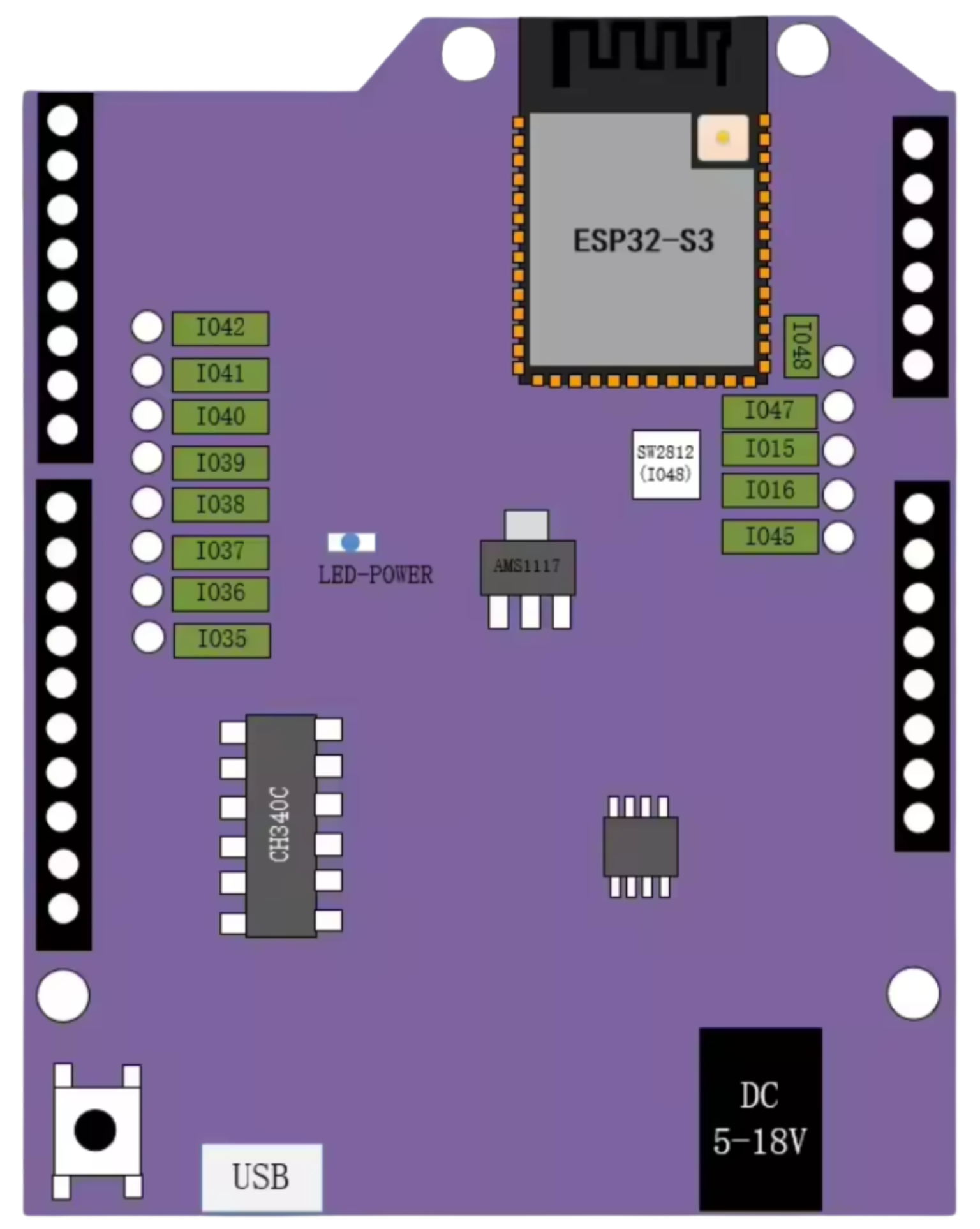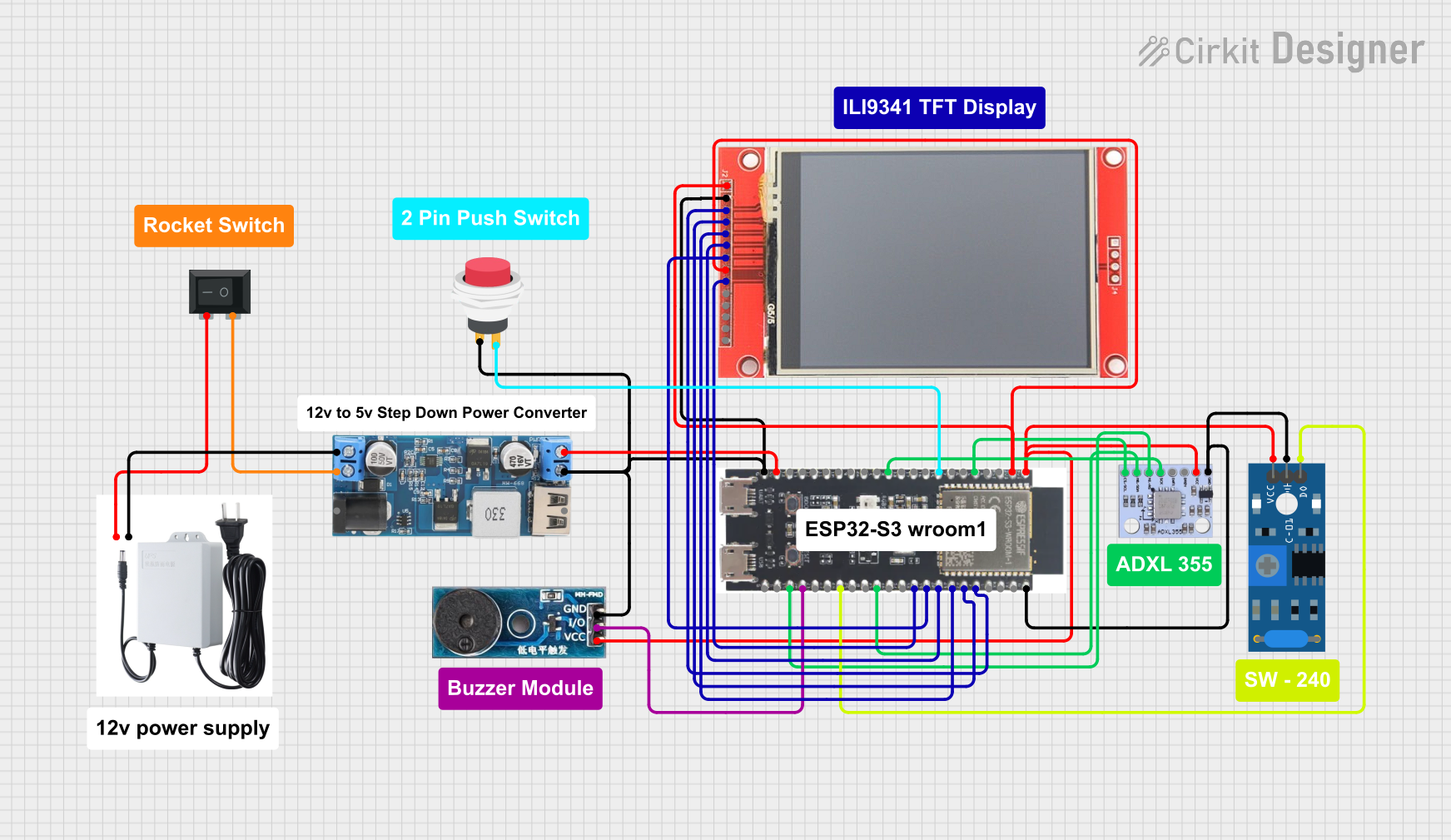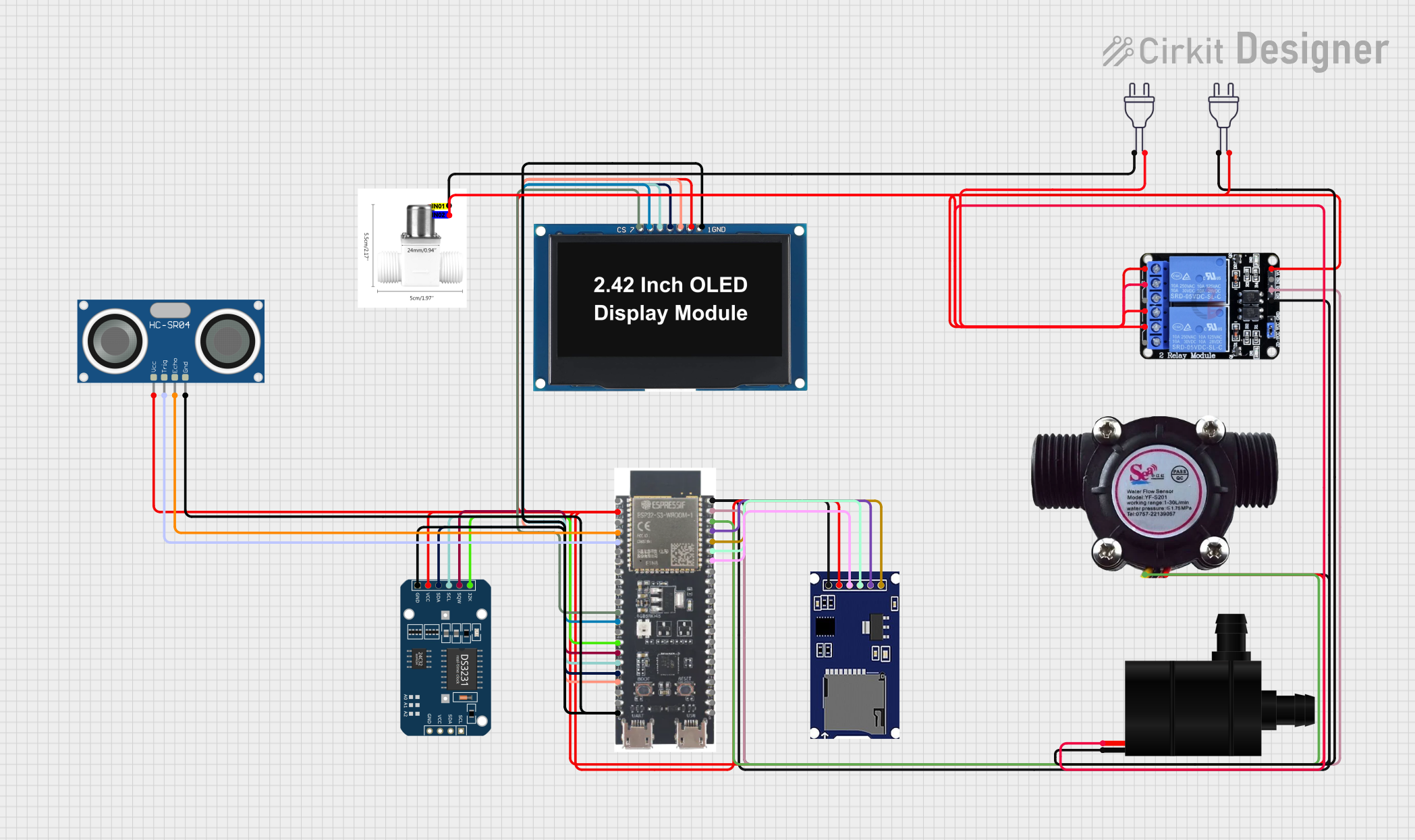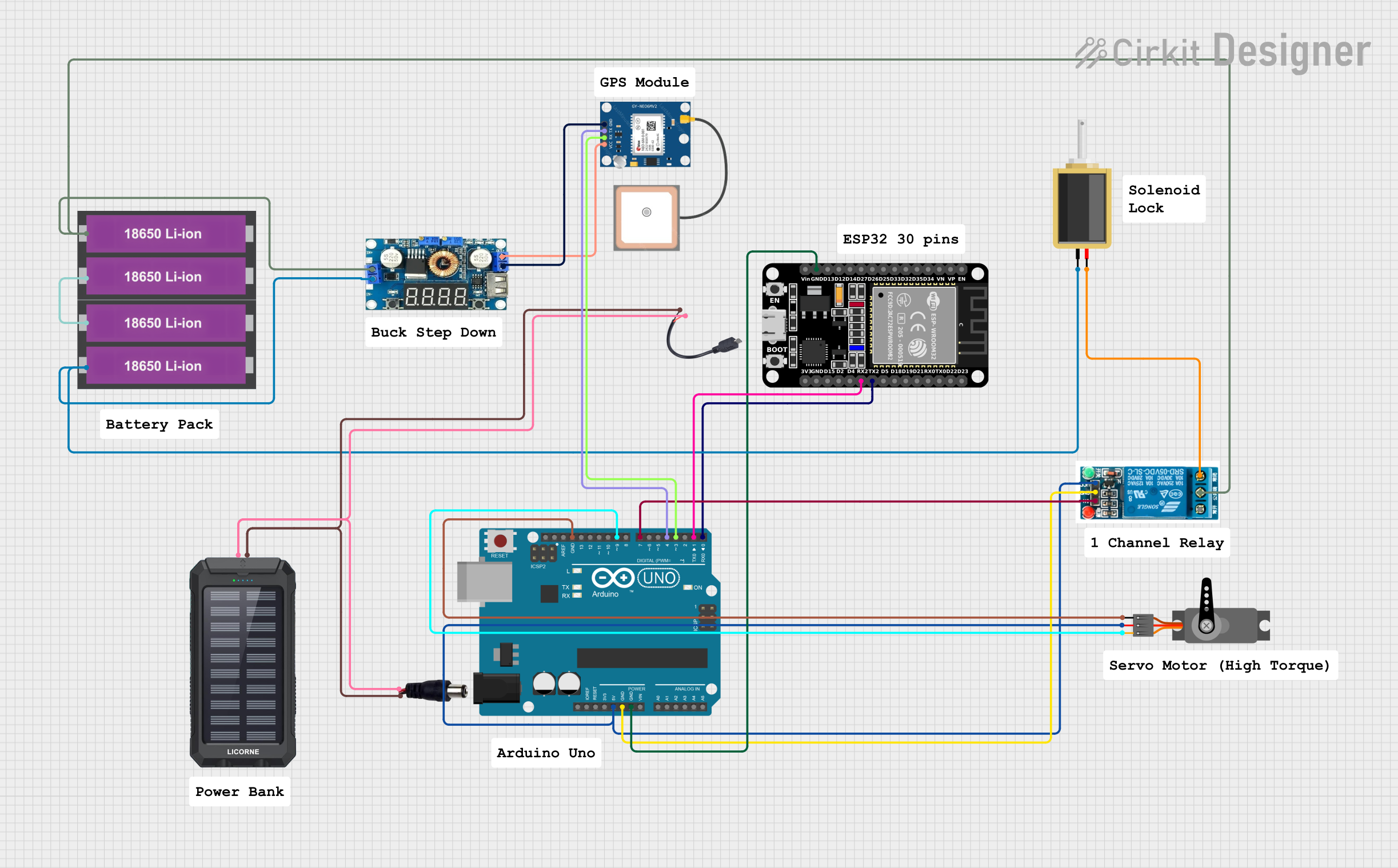
How to Use ESP32-S3 UNO: Examples, Pinouts, and Specs

 Design with ESP32-S3 UNO in Cirkit Designer
Design with ESP32-S3 UNO in Cirkit DesignerIntroduction
The ESP32-S3 UNO is a microcontroller board built around the ESP32-S3 chip, which features dual-core Xtensa LX7 processors, integrated Wi-Fi, and Bluetooth 5.0 connectivity. This board is designed for Internet of Things (IoT) applications, offering robust wireless communication capabilities and support for a wide range of peripherals. Its compatibility with the Arduino IDE and MicroPython makes it an excellent choice for both beginners and experienced developers.
Explore Projects Built with ESP32-S3 UNO

 Open Project in Cirkit Designer
Open Project in Cirkit Designer
 Open Project in Cirkit Designer
Open Project in Cirkit Designer
 Open Project in Cirkit Designer
Open Project in Cirkit Designer
 Open Project in Cirkit Designer
Open Project in Cirkit DesignerExplore Projects Built with ESP32-S3 UNO

 Open Project in Cirkit Designer
Open Project in Cirkit Designer
 Open Project in Cirkit Designer
Open Project in Cirkit Designer
 Open Project in Cirkit Designer
Open Project in Cirkit Designer
 Open Project in Cirkit Designer
Open Project in Cirkit DesignerCommon Applications and Use Cases
- IoT devices and smart home automation
- Wireless sensor networks
- Wearable technology
- Robotics and drones
- Prototyping and development of connected devices
- Real-time data monitoring and logging
Technical Specifications
Key Technical Details
- Microcontroller: ESP32-S3 (Xtensa LX7 dual-core processor)
- Clock Speed: Up to 240 MHz
- Flash Memory: 8 MB (varies by model)
- SRAM: 512 KB
- Wireless Connectivity: Wi-Fi 802.11 b/g/n and Bluetooth 5.0 (LE)
- Operating Voltage: 3.3V
- Input Voltage (VIN): 5V (via USB or external power supply)
- GPIO Pins: 21 (configurable for digital I/O, PWM, ADC, etc.)
- ADC Channels: 12-bit, up to 20 channels
- Communication Interfaces: UART, SPI, I2C, I2S, CAN, and USB OTG
- USB Interface: USB Type-C
- Power Consumption: Ultra-low power modes supported
- Dimensions: Compatible with Arduino UNO form factor
Pin Configuration and Descriptions
The ESP32-S3 UNO features a pinout similar to the Arduino UNO, making it easy to integrate into existing projects. Below is the pin configuration:
| Pin | Name | Description |
|---|---|---|
| 1 | VIN | Input voltage (5V) for powering the board. |
| 2 | GND | Ground pin. |
| 3 | 3V3 | 3.3V output for powering external components. |
| 4 | GPIO0 | General-purpose I/O pin, also used for boot mode selection. |
| 5 | GPIO1 | General-purpose I/O pin. |
| 6 | GPIO2 | General-purpose I/O pin, supports ADC and PWM. |
| 7 | GPIO3 | General-purpose I/O pin, supports ADC and PWM. |
| 8 | TXD (GPIO43) | UART transmit pin. |
| 9 | RXD (GPIO44) | UART receive pin. |
| 10 | SDA (GPIO8) | I2C data line. |
| 11 | SCL (GPIO9) | I2C clock line. |
| 12 | SPI_MOSI | SPI data output. |
| 13 | SPI_MISO | SPI data input. |
| 14 | SPI_SCK | SPI clock line. |
| 15 | SPI_CS | SPI chip select. |
| 16 | ADC0-ADC19 | Analog input pins (12-bit resolution). |
| 17 | EN | Enable pin to reset the board. |
| 18 | USB D+ | USB data positive line. |
| 19 | USB D- | USB data negative line. |
Usage Instructions
How to Use the ESP32-S3 UNO in a Circuit
Powering the Board:
- Connect the board to your computer using a USB Type-C cable for power and programming.
- Alternatively, supply 5V to the VIN pin for external power.
Programming the Board:
- Install the Arduino IDE and add the ESP32 board manager URL in the preferences.
- Install the ESP32 board package via the Board Manager.
- Select "ESP32-S3 Dev Module" as the board type and the correct COM port.
Connecting Peripherals:
- Use the GPIO pins for digital I/O, PWM, or ADC as needed.
- Connect sensors, actuators, or other devices to the appropriate pins.
Uploading Code:
- Write your code in the Arduino IDE or MicroPython environment.
- Click the upload button to flash the code to the ESP32-S3 UNO.
Important Considerations and Best Practices
- Ensure the input voltage does not exceed 5V to avoid damaging the board.
- Use level shifters when interfacing with 5V logic devices, as the ESP32-S3 operates at 3.3V.
- Avoid connecting high-current loads directly to GPIO pins; use external drivers or relays.
- Use pull-up or pull-down resistors for stable input signals on GPIO pins.
Example Code for Arduino IDE
The following example demonstrates how to blink an LED connected to GPIO2:
// Define the GPIO pin for the LED
#define LED_PIN 2
void setup() {
// Set the LED pin as an output
pinMode(LED_PIN, OUTPUT);
}
void loop() {
// Turn the LED on
digitalWrite(LED_PIN, HIGH);
delay(1000); // Wait for 1 second
// Turn the LED off
digitalWrite(LED_PIN, LOW);
delay(1000); // Wait for 1 second
}
Troubleshooting and FAQs
Common Issues and Solutions
Board Not Detected by Computer:
- Ensure the USB cable is functional and supports data transfer.
- Check if the correct COM port is selected in the Arduino IDE.
- Install the necessary USB drivers for the ESP32-S3.
Code Upload Fails:
- Verify that the correct board type is selected in the Arduino IDE.
- Press and hold the BOOT button while uploading the code.
Wi-Fi Connection Issues:
- Double-check the SSID and password in your code.
- Ensure the router is within range and supports 2.4 GHz Wi-Fi.
GPIO Pin Not Responding:
- Confirm that the pin is not being used by another peripheral.
- Check for loose or incorrect connections in the circuit.
FAQs
Q: Can I use the ESP32-S3 UNO with MicroPython?
A: Yes, the ESP32-S3 UNO supports MicroPython. Flash the MicroPython firmware to the board and use a compatible IDE like Thonny.Q: What is the maximum current output of the GPIO pins?
A: Each GPIO pin can source or sink up to 40 mA, but it is recommended to limit the current to 20 mA for safe operation.Q: Does the ESP32-S3 UNO support deep sleep mode?
A: Yes, the ESP32-S3 supports ultra-low power deep sleep mode for energy-efficient applications.Q: Can I use the ESP32-S3 UNO with 5V sensors?
A: Yes, but you will need level shifters to convert the 5V logic to 3.3V.
This documentation provides a comprehensive guide to using the ESP32-S3 UNO for your IoT and prototyping needs.